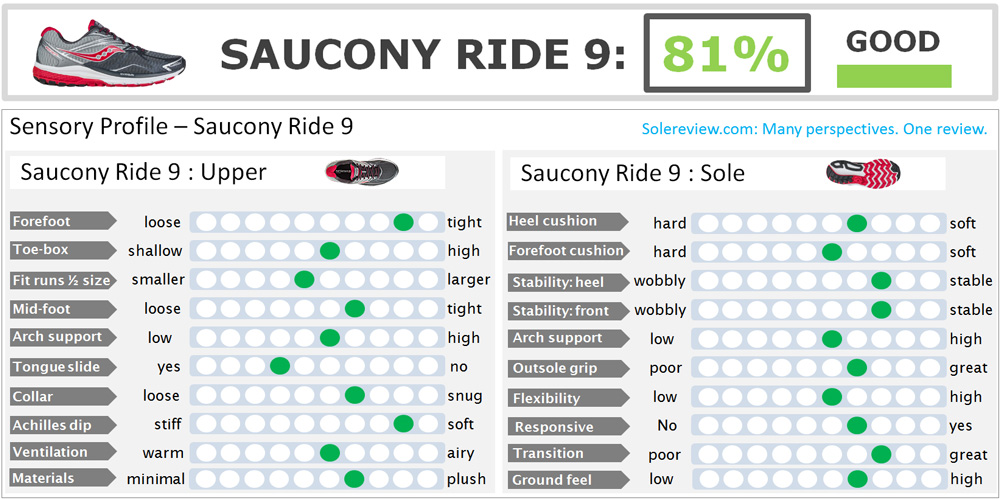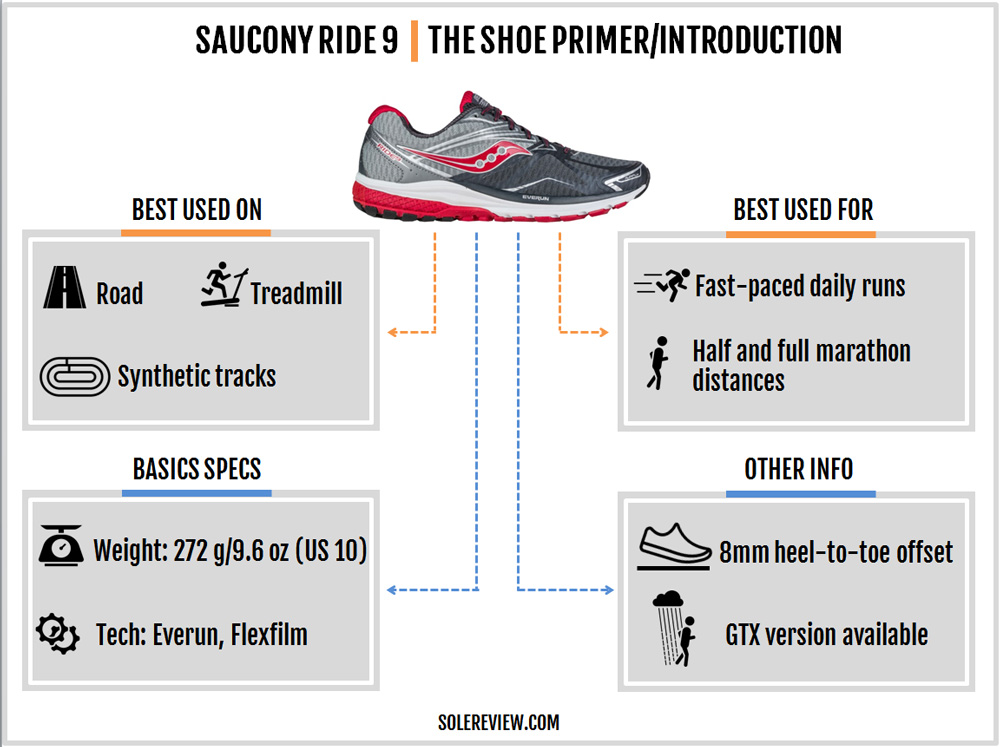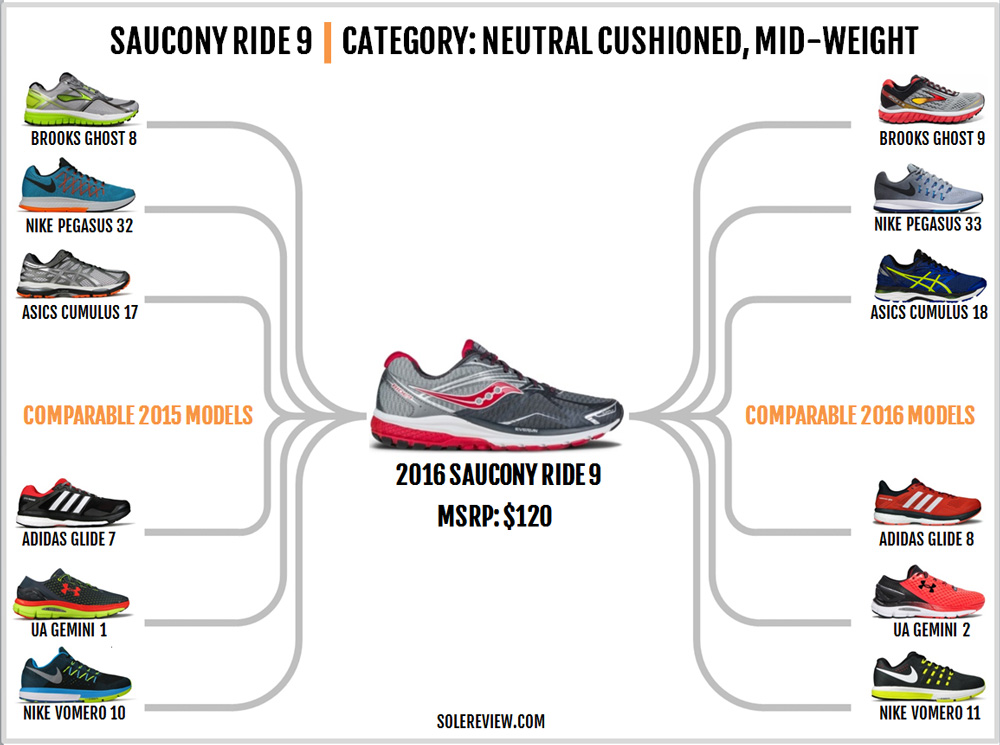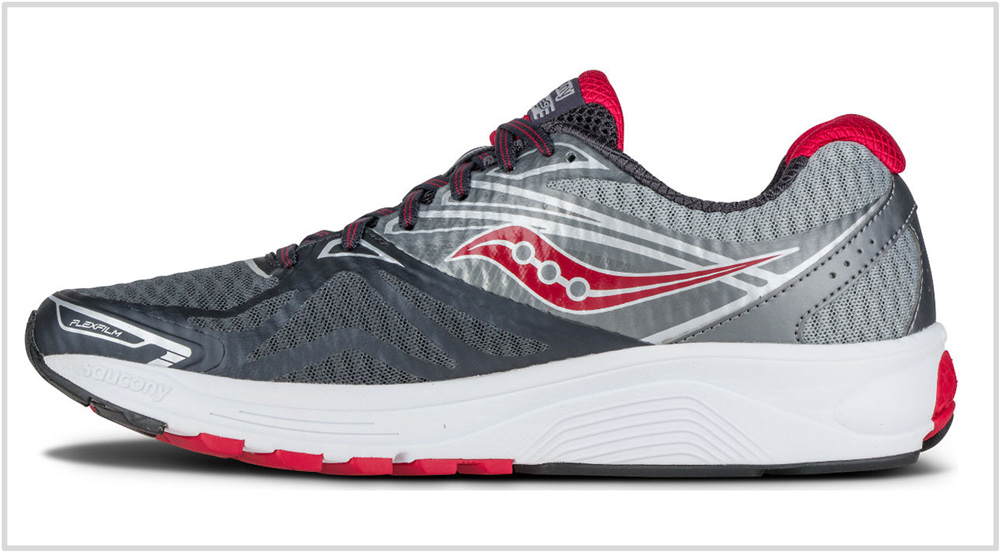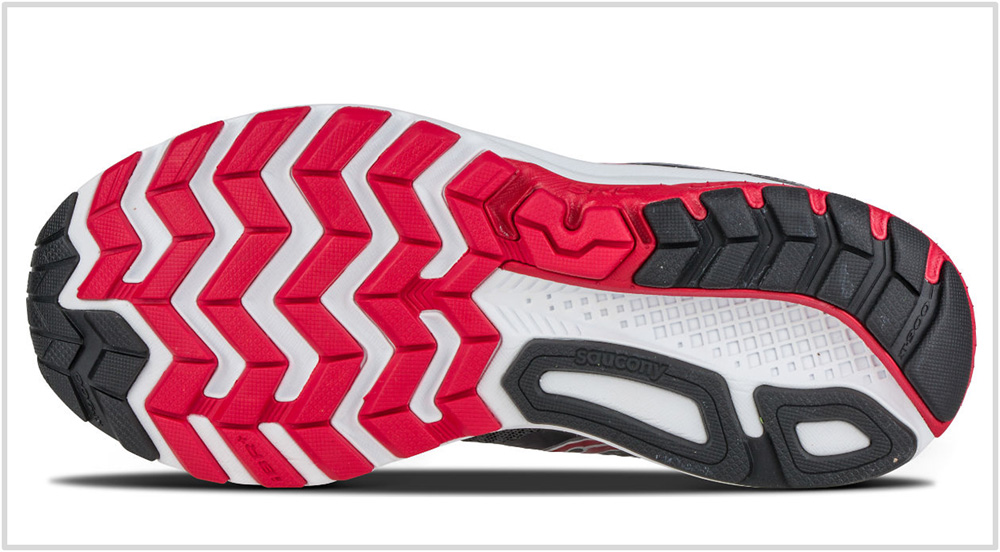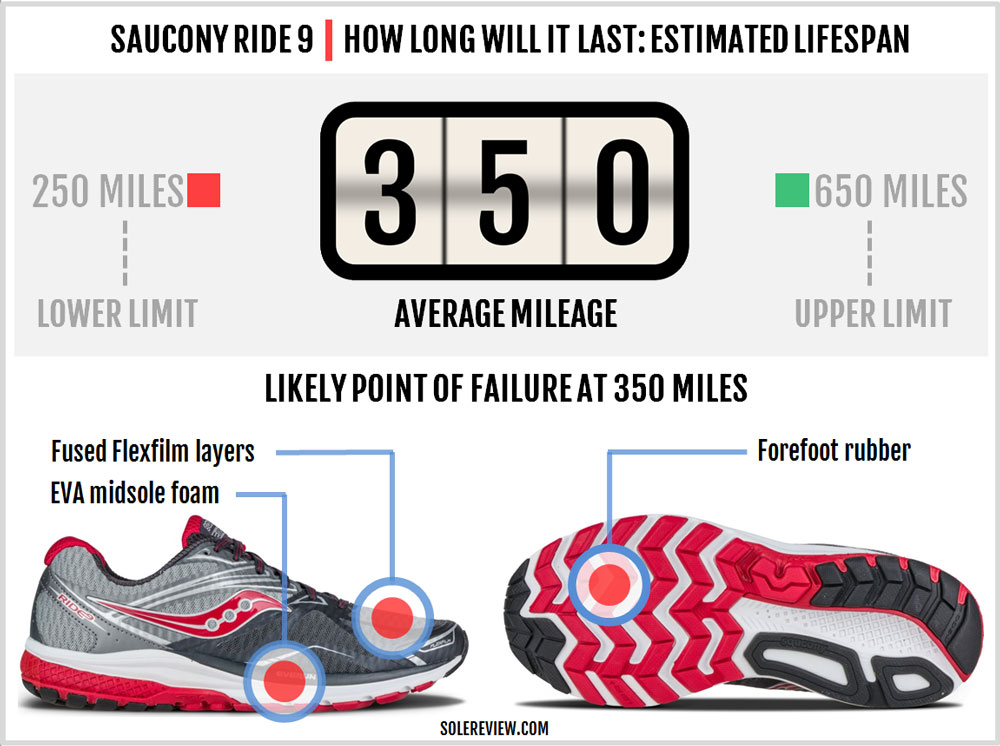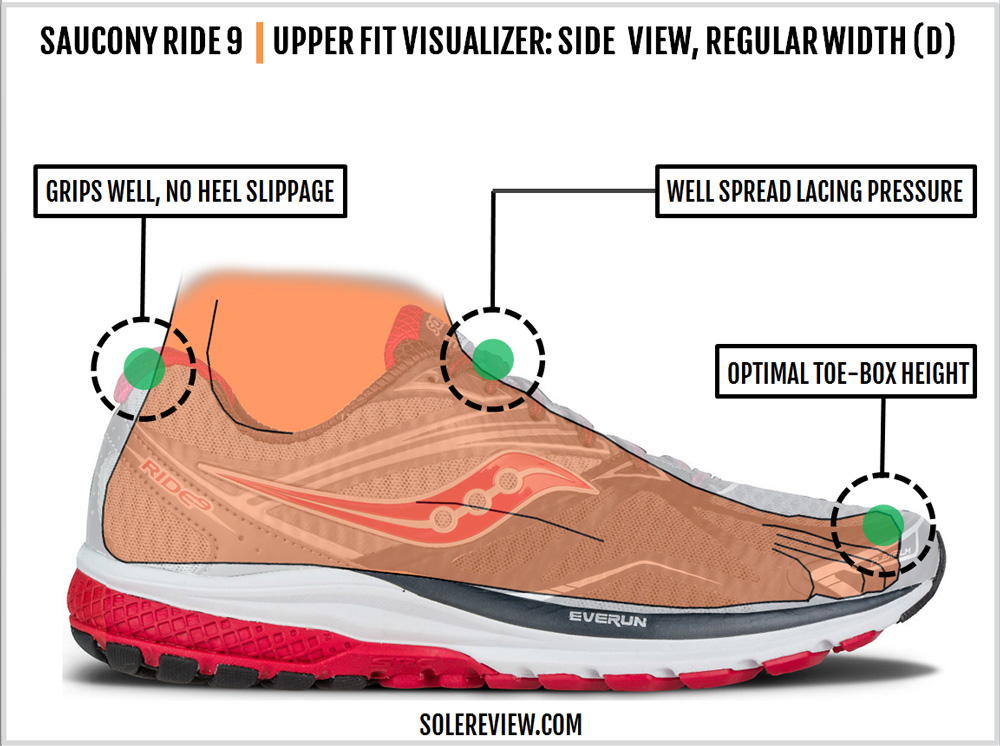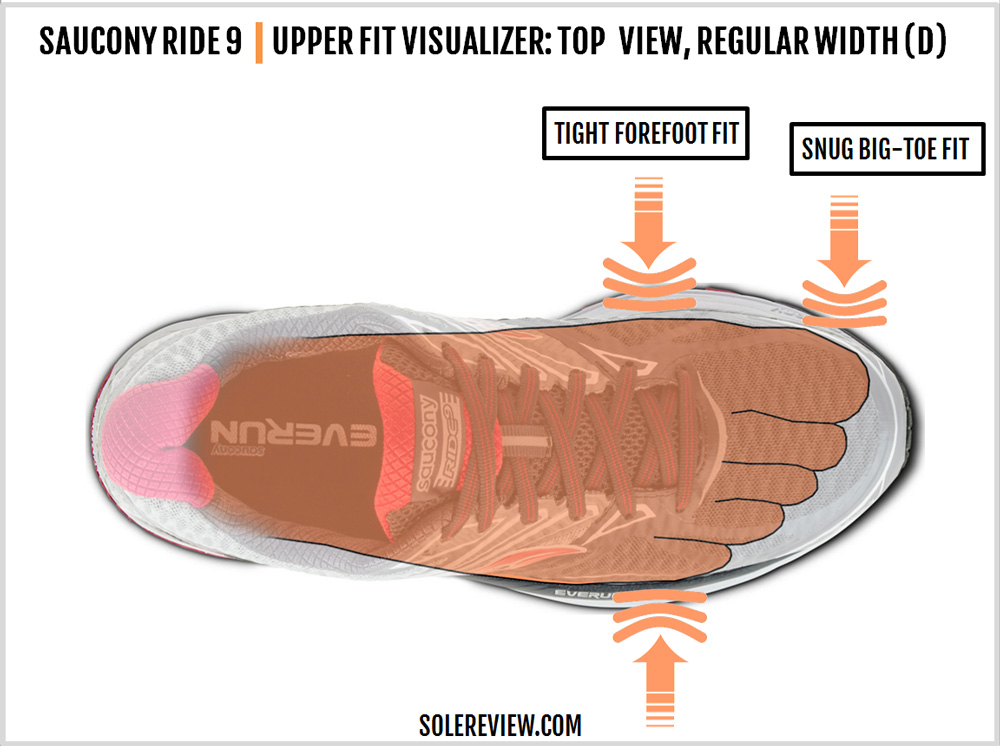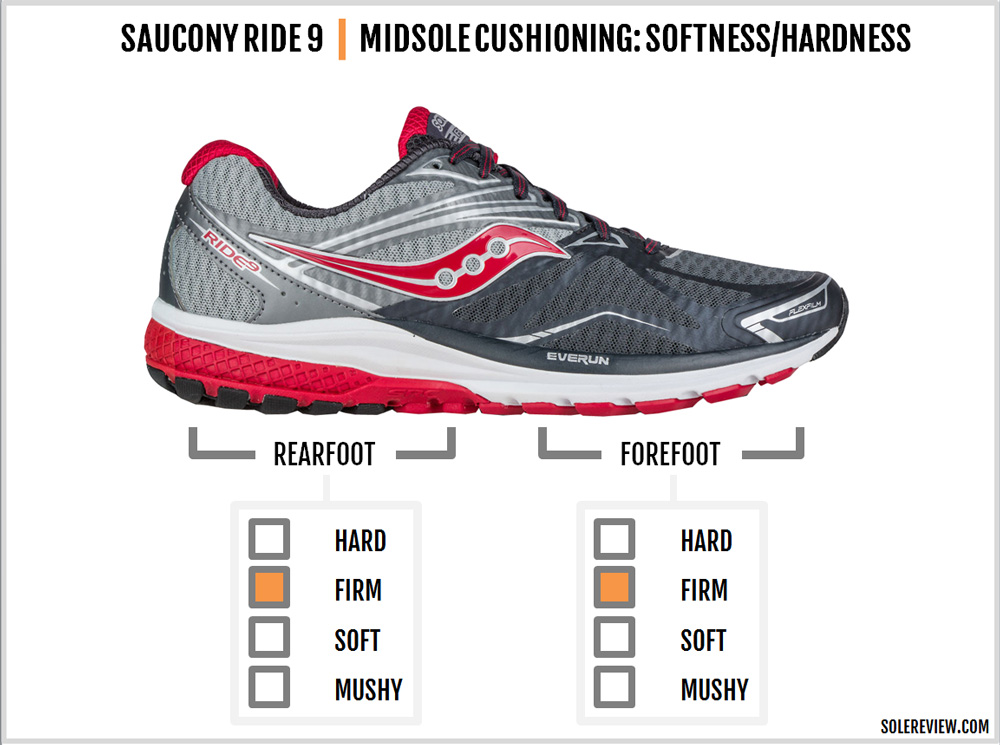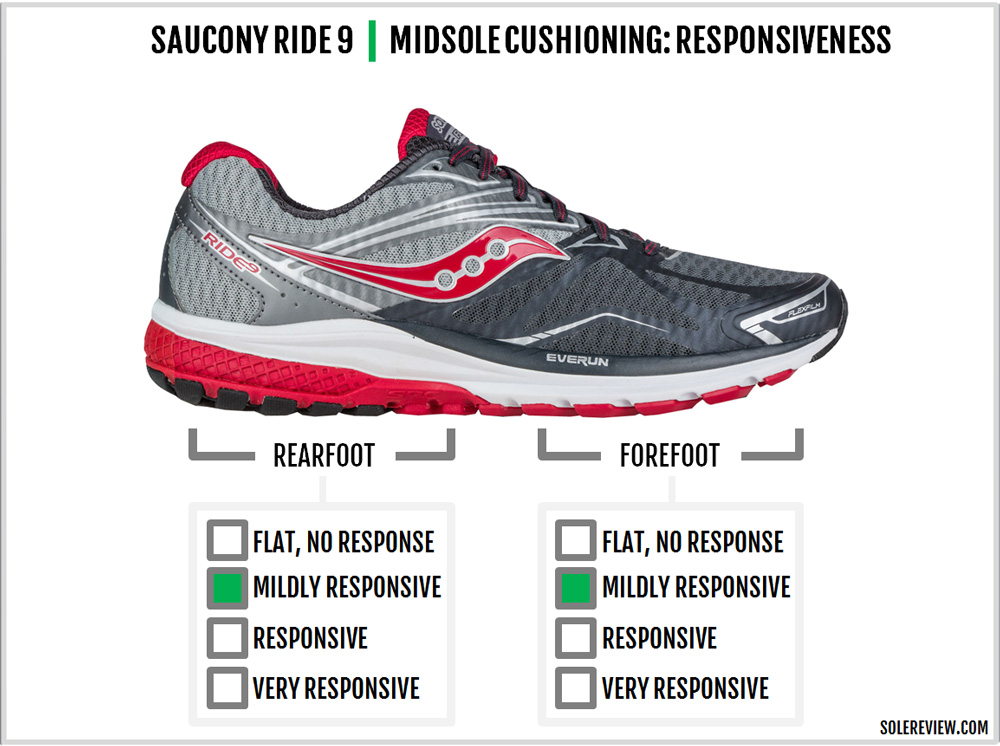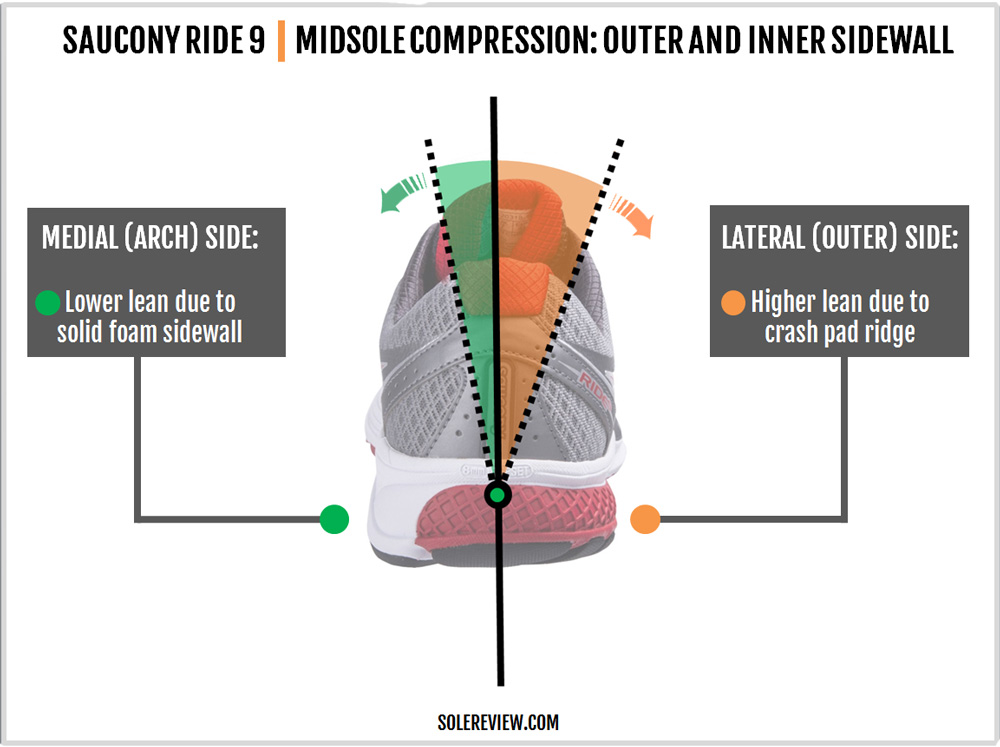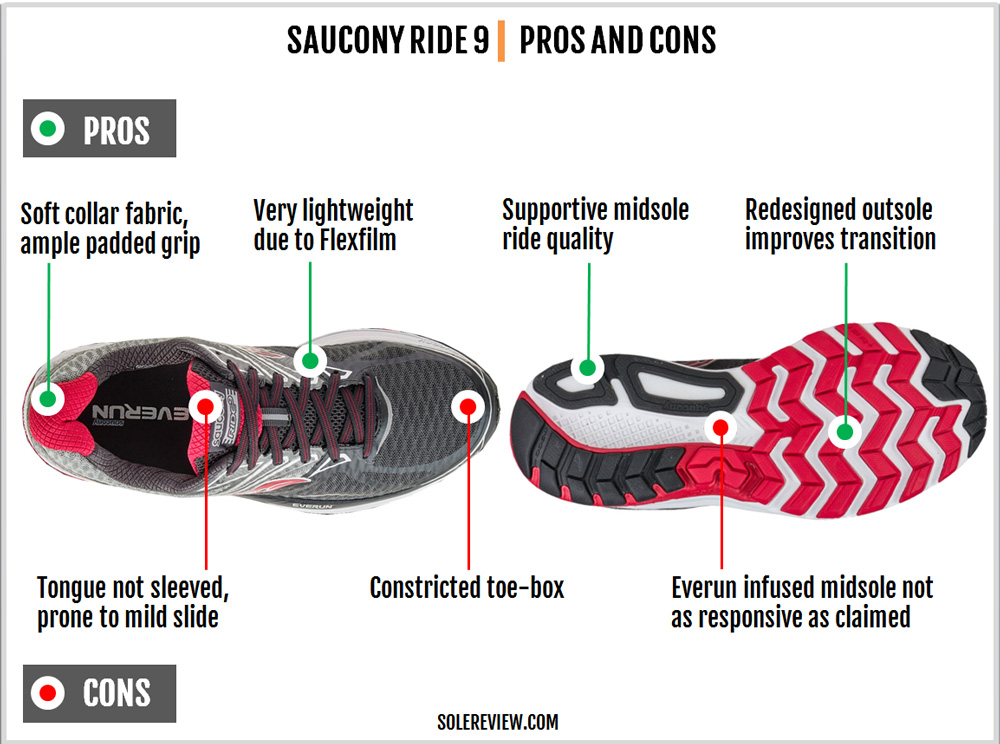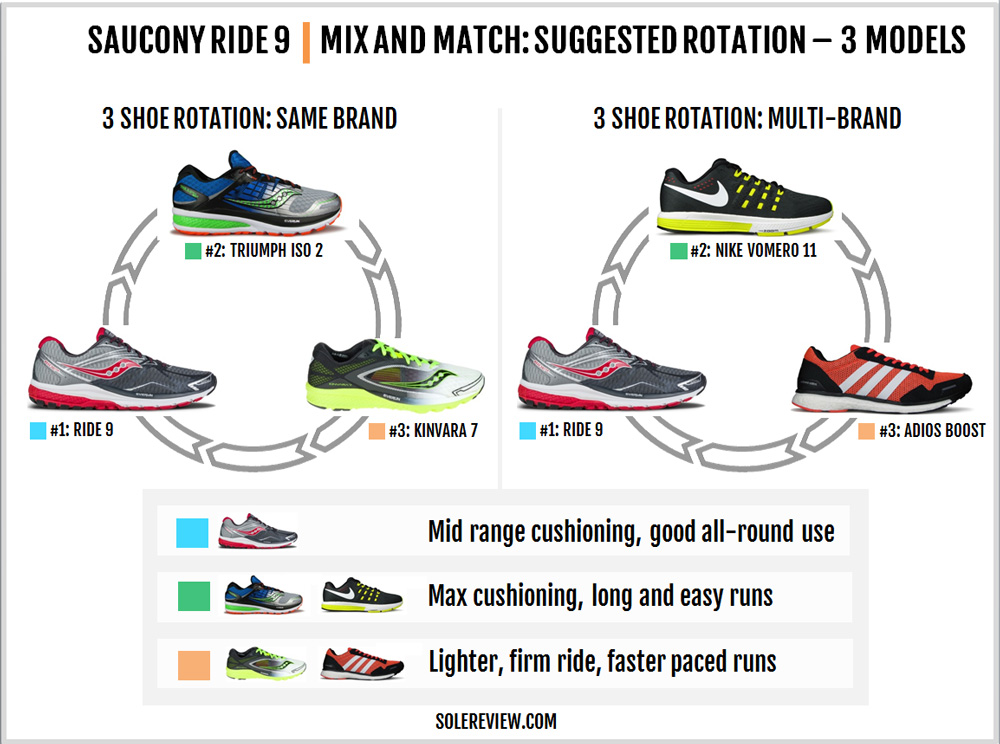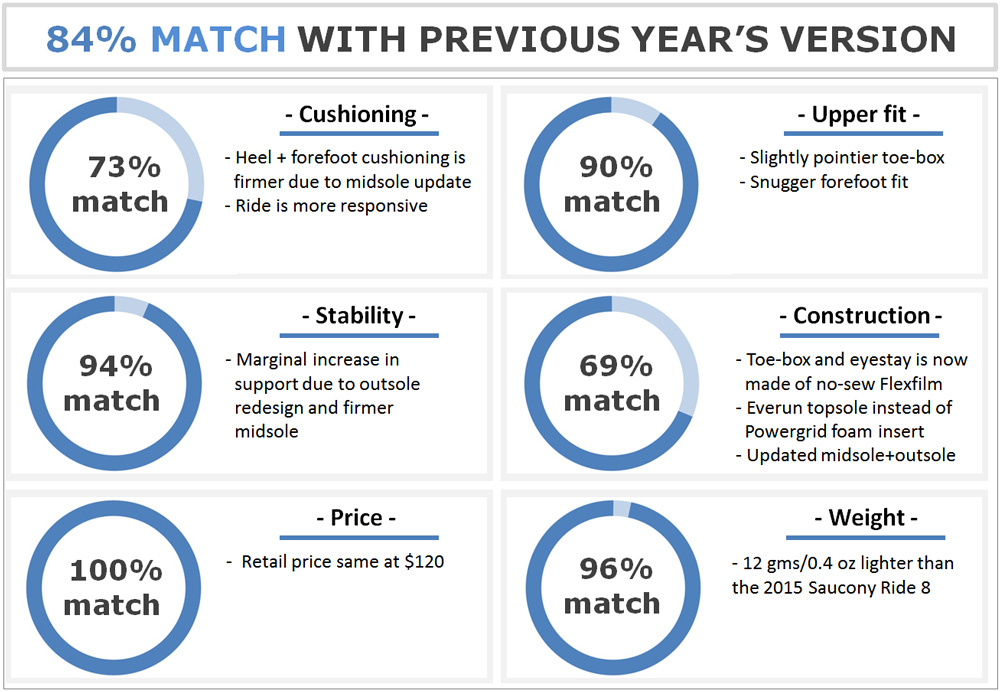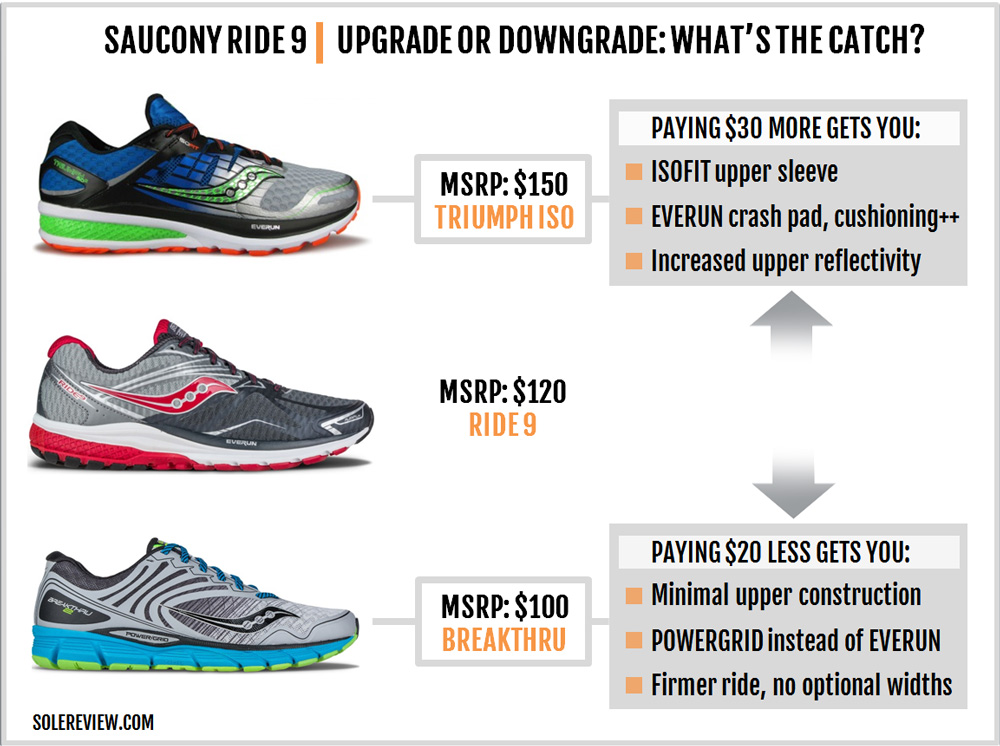INTRODUCTION
The Saucony Ride 9 is a bit late to the Everun party, making it to the market after the Triumph ISO 2 and Guide 9 updates. Don’t know what we’re talking about? Saucony recently updated many of their core models to accommodate their new Everun cushioning tech.
You can learn more about the Everun in our breakdown of the Triumph ISO 2, but know that the Everun is similar to the adidas Boost foam as far as the material is concerned.
Where Everun differs from adidas’s runaway hit is in its design execution. Whereas adidas resorts to a midsole hewn fully out of the Boost foam, Everun just offers a teaser in the form of a ‘Topsole’ slice or a heel crash pad.
The Everun infusion does alter the ride character of the shoe, though not in the same league as adidas Boost. We’ll spend a little more time talking about the change, and how the Ride 9 compares vs. the Ride 8.
The introduction of Everun doesn’t change the positioning of the Saucony Ride 9. All brands have their neutral cushioning staple, and the Ride is Saucony’s racehorse. The same way how the Supernova Glide is for adidas, the Pegasus is for Nike and the Ghost for Brooks.
The Ride 9 is substantially lighter than most of other competing models in this category. At 272 grams/9.6 Oz for a half pair of US 10, it is lighter than shoes such as the Cumulus, Glide, Gemini and the Pegasus.
All these models are good for a wide range of use and surfaces. For example, one can use the Ride 9 for long and easy runs, or go for shorter runs of medium tempo.
And how does the Everun equipped Ride 9 fare against the competition?
The way solereview sees it, Saucony’s Everun tech competes directly with adidas Boost – given that Everun is fundamentally the same (at a material level) as Boost. That said, it is worth pointing out that while the Glide Boost uses a full Boost midsole, Saucony use of Everun is miserly.
Since the Ride 9 uses just the ‘Topsole’ over a standard EVA midsole, it lags behind the wholesome responsiveness of the Glide Boost. The $10 cheaper Nike Pegasus 33 has the edge over the Ride 9 too with its front and rear Zoom bags.
As far as responsive neutral models are concerned, we’d place the Ride 9 below the Glide and the Pegasus. On the other hand, the Ride 9 can hold its own against other shoes such as the UA Speedform Gemini, Brooks Ghost 9 and the Cumulus.
DESIGN AND MATERIALS
There’s a recurring design update theme cutting across successive Ride versions, and that happens to be the increasing use of Flexfilm. It’s apparent in the Ride 7 to Ride 9 evolution.
The Ride 7 combined a stitched toe-bumper, lacing eyestay and heel with sections of thick TPU welding. Last year, the Ride 8 switched most of the thicker welding with thinner Flexfilm and pared down the (previously bulky) eyestay.
Speak of the Ride 9, and Flexfilm spreads wider over the upper landscape. The toe-bumper is now reinforced Flexfilm instead of being stitched-on, and the lacing eyestay goes the stitch-less way too.
Only the heel area retains the old school stitched-on component, and we’re pretty sure that next year’s Ride 10 will do something about it.
Another Saucony trend has been the steady decline in the use of reflective elements. The Ride 7’s streetlight levels of reflectivity was drastically cut down on the Ride 8. And when we thought that was the limit, Saucony outdoes itself on the Ride 9.
Reflectivity has been downsized to a small heel strip and a single arc in front, along with the bit on the tongue loop. This update makes the Ride 8’s reflective trims look generous. How times have changed.
There’s an upside to the whole Flexfilm business, and that’s Ride 9’s improved weight loss. The difference of 12 gms/0.4 oz is significant in this weight class, and it shows that switching to no-sew layers not only reduces aesthetic heaviness but empirical mass as well.
Apart from the changes, you’ll see a few familiar bits carried over from past Ride versions. The tongue and heel collar is built using the same Rundry textile, although with a minor construction update.
The heel collar is now split into part two parts, with the Achilles area getting a different colored section of Rundry lining. The Achilles dip is softer on the Ride 9 compared to the 8.
Whereas the Ride 8 had a strip of synthetic flanking upwards, the Ride 9’s upper Achilles area is more foam and less synthetic.
The semi-elastic, flat laces are also from Saucony’s standard material library and has been used on many models, past and present. The tongue is un-sleeved, and remains one of the few models in this category to be so.
The lower part of the Ride 9 is where you’ll see most of the new updates. The new midsole sports a more streamlined sidewall profile instead of the pod-like design of the Ride 7 and 8. Both the heel and forefoot sections lack the distinct grooving seen over the past couple of years.
Under the heel, the Ride 9 has a waffle textured crash pad. But unlike the more expensive Triumph ISO 2 with an Everun Crash pad, the Ride just uses an EVA crash pad with a similar waffle imprinted aesthetic.
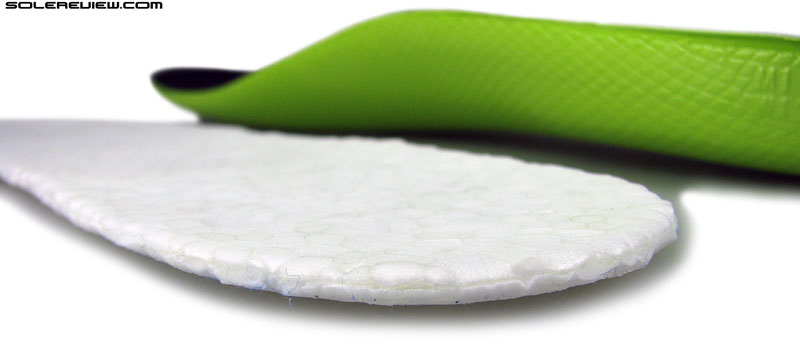
Everun is used inside the Ride 9 only as a thin sheet below the insole. Above it is the molded insole and below it is a firm EVA base with cavities punched into them. This new arrangement replaces the Powergrid insert of the Ride 7 and 8 and the foam lasting above it. The Ride 9 switches to a textile based lasting this year.
The outsole has been thoroughly reworked. The net result is a mixture of give and take when compared to the Ride 8. Under the back, there’s reduced articulation – meaning that the Ride 9 relies less on grooving and separate components than the Ride 8.
The section over medial outsole is now one rubber piece instead of two, and the outer edges lack the deep grooving seen on the Ride 8. The forefoot moves away from the legacy layout to the new Chevron design – something which we’ve already seen on the Triumph ISO 2 and Guide 9.
As far as the material combination is concerned, the Ride 9 is the same as Ride 8. The underside of the mid and rearfoot is shielded by a harder variety of rubber while the forefoot is overlaid with softer blown rubber.
One would assume the Ride 9 to be more flexible than the Ride 8 because of the Chevron outsole with exposed foam running sideways. But the overall flexibility stays the same because the midsole sides not longer have the pod-like structures which made the Ride 8’s midsole easier to bend.
On an average, the Saucony Ride 9 should last 350 miles. After that mileage, one or more parts of the shoe will begin to fail. Since the midsole is nearly all foam, it will start losing its cushioning properties.
Wear and tear will also happen on the upper, as the Flexfilm layers gradually peel off or crack. The forefoot outsole is blown rubber, so it will shred faster than the rear. The rate of wear will happen quicker for forefoot landers than rearfoot strikers.
UPPER FIT AND FEEL
The Ride 9 fits true-to-size with a few caveats. While the toe-box isn’t shallow, it is marginally lower in height than the Ride 9. There’s also less freedom to wiggle your toes around, and both of these characteristics are linked to the use of molded Flexfilm.
Both the Ride 7 and 8 had stitched-on toe-bumpers which not only increased the height but also afforded some leeway for movement. In comparison, the Ride 9’s toe-box feels less forgiving when it comes to freedom of movement.
The heel fits well; the foot is cocooned within the plush confines of the generously padded collar. The Achilles dip is softer than last year because the upper part is all foam and no synthetic unlike how it was on the Ride 8.
The heel fit could have been better if the Ride 9 came with an inner sleeve and a tongue which did not slide at all. Saucony hasn’t been great when getting the midfoot fit right for many of its core models.
You see, when the tongue shifts sideways, there’s less of the upper locking the foot down in place. A sleeve keeps the tongue where it should always be – centered, and helping improve the quality of heel fit.
The Ride 9 forefoot fits narrow. Looking back, that’s been the case for not only both the Ride 7 and Ride 8 but also the Guides.
Sure, a part of how the forefoot feels could be attributed to the pointy toe-box and Flexfilm, but if those can’t be the only factors responsible. Else how would you explain the earlier Ride versions with a roomier forefoot fit?
The fit personality has likely to do with Saucony’s last, and it is high time the brand revised it. It doesn’t help that most of Saucony shoes do not come in multiple widths. The Ride 9 does come in a wide, but going by reader feedback that option isn’t available in most countries outside the United States.
Another possible cause affecting upper fit is how the Everun topsole has been used. If you lift up the sheet, you’ll notice that Everun sits on top of the lasting, and not below it like last year’s Powergrid.
The question is, does this new arrangement eat up into precious upper space?
We’re sure that Saucony has made adjustments to deliver a zero-sum fit, but still, this is some foam for thought.
RIDE QUALITY AND BEHAVIOR
The Ride 9 is not a soft riding shoe. It is firmer than the Ride 8, and that’s because of a couple of factors.
To begin with, the firmness has to do with the Everun change. Hey, wait a second. Isn’t the Everun supposed to make the shoe softer and not the other way around?
In the Ride 9, Everun’s presence is superficial. It just happens to be a thin sheet below the foam insole, so its contribution to the Ride 9’s cushioning character isn’t a lot.
Also remember that the Everun sheet comes at the expense of excluding both the softer Powergrid insert and the foam strobel/lasting of the Ride 8.
All this makes the Ride 9’s midsole below Everun run firmer than it used to.
Secondly, the outsole design lets go of the podular design in areas under the heel and the forefoot. The pod-like outsole lugs mounted on the 2015 Ride 8’s midsole acted as independent cushioning units, hence enhancing cushioning softness.
Contrast that with this year’s Ride 9 outsole (and midsole) design, which is a more filled-up kind.
Like most shoes, it is easy to confuse the feedback from the insole and midsole as coming from the Everun layer. Everun does increase responsive behavior, but only marginally.
Saucony’s signature tech is sandwiched between two soft components – the EVA midsole and insole. So it takes a bit of an effort to extract the responsive qualities of Everun; it certainly is not noticeable during walking or fit-trials.
One should expect the Everun to become reactive only during medium paced workouts. Even so, the Everun experience is limited to the upper confines of the midsole instead of being deep and centered.
On a side note, if you already know what adidas Boost feels like, then it is likely that Saucony’s rationed quantity of Everun will disappoint.
With a firm midsole and revised outsole design, the Ride 9’s supportive quality doesn’t come as a surprise.
Ride is stable due to the forefoot flare and firm ride, filled-up midfoot and the Chevron forefoot – the latter makes for better/smoother transitions. We also have to highlight the exposed transition groove running under the midsole. This is the section which parts either side of the outsole; the open foam channel keeps the body-weight centered.
Like most shoes, the heel midsole compression is biased towards the outer side. The crash pad (colored in red) is softer than the medial (arch) side, and there is a ridge between it and the rest of the midsole. This makes that side of the midsole softer but within acceptable tolerances.
The Ride 9 improves on the quality of transitions. The loss of podular outsole design cuts down on softness, but in doing so, it makes for a connected ride experience. The uniform coverage of rubber under the forefoot combined with increased firmness facilitates quicker toe-offs.
PROS AND CONS
The Saucony Ride 8 was already the lightest among rivals in its class, and the Ride 9 goes a level up. Thanks to the use of Flexfilm, the shoe loses a whopping 12 grams/0.4 Oz.
Transition quality and the level of ride support has improved with the increased firmness, an effect of reworking the midsole and outsole design.
On the negative side of things, we have to call out the Ride 9’s tight forefoot fit along with the pointy toe-box. Then there’s a matter of Everun itself; the ride isn’t as responsive as Saucony claims it is.
RECOMMENDED ROTATION
You can toss in a few other models along with the Ride 9. If you want to stick to Saucony, then Triumph-Ride-Kinvara is the way to go. You’ll get a good mix of plush, firm and lightweight with this rotation approach.
On the other hand, you can diversify your footwear portfolio by having a look at other brands. The Nike Vomero 11 is a good blend of plush and responsive, while the firmer and faster feeling adios can make short work of those tempo runs.
SUMMARY
There are numerous updates on the Ride 9, but there are only three changes one needs to care about. One, the forefoot area has a tighter fit. Two, the new shoe has a firmer ride. And three, the Ride 9 sheds a good deal of weight.
Summing it up, we’ve got mixed feelings about the Ride 9 update. In a way, the earlier Powergrid embedded versions (Ride 7, 8) held their own with a soft core surrounded by a supportive midsole.
The Ride 9 remains a well-rounded shoe capable of most tasks, no two ways about that. It is lightweight and firm enough for tempo runs, and is comfortable enough for running longer.
But here’s the thing. As a standalone cushioning material, Everun works. After all, it is inspired by adidas’s Boost foam, regardless of how Saucony tries to sell it. The problem is when you try to sell a pizza slice (Everun) for the same price of a whole pizza (Glide Boost).
That approach simply doesn’t make the grade. Offering a thin sheet of Everun vs. a full Boost midsole makes the Ride 9 look like a Glide Boost wannabe. Everun in its current form is more PR department fluff than actual performance, and in a way it has shades of Saucony’s Powergrid+ tech.
Many were offended when we said uncharitable things about the cavities-punched-into-the-foam ‘technology,’ but where’s Powergrid+ now?
The interesting thing is that while Powergrid+ continues to be used in the Triumph ISO 2, Guide 9 and the Ride 9, there is no mention of it. As it never existed.
If it’s any consolation, Saucony is going to release the Freedom with a full Everun midsole in December. We’re curious to see how it compares against some of adidas’s $150+ Boost based shoes.
The way things stand today, the alternatives are the $150 Saucony Triumph ISO 2 on the upward scale and the Breakthru 2 at a lower MSRP of $100.
Like the Ride 9, the Triumph ISO 2 combines an EVA midsole with an Everun topsole; the only difference is that it uses an Everun heel crash pad (on a thicker midsole) instead of the EVA foam type on the Ride 9.
The Breakthru 2 has an 8 mm heel offset, a rubber outsole, and a snug fitting upper. And instead of Everun, it has a tried and tested Powergrid insert – reminiscent of the older Ride models.
Take your pick.

